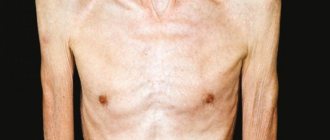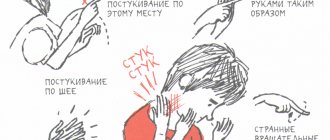What is asthenic syndrome
Asthenic syndrome in adults
may have the following characteristics:
- First of all, it is an indicator of fatigue and overstrain. In the case of hard work, several jobs, or having to overwork, working at night, then in the morning there is a feeling of fatigue, weakness, decreased mood, sensitivity to smells and bright lighting, decreased endurance to usual stress, the appearance of headaches or exacerbation of migraines. This condition usually goes away after proper sleep and rest, excluding external stimuli.
- The reaction of the nervous system is of the “protective” type. This is a process that was inherent in our body during the process of evolution, helping to protect our mental processes from reboot due to the influence of various external and internal factors. It is based on the extreme inhibition reflex. This mechanism is triggered upon the occurrence of asthenia, when a threat to the body arises. An example is when a student is preparing for an exam and tries to study the materials for the entire semester on the last evening, then absent-mindedness, decreased concentration, headache, etc. occur. Thus, asthenia occurs as a defensive reaction notifying the body of a possible threat.
- Diseases. An asthenic state
also occurs with the development of certain diseases of the cardiovascular, endocrine systems, oncopathology, mental disorders, etc.
For example, the first stages of the disease with acute viral infections are indicative, when weakness, fatigue, drowsiness and irritability occur even before the body temperature rises and other characteristic symptoms appear. For some conditions, on the contrary, only signs of asthenia : hypertensive crisis, mild concussion, recovery from anesthesia. Most diseases still begin with asthenia and continue with the development of other symptoms. And during recovery, asthenia is still possible. Asthenic disorder
in adult women often accompanies premenstrual syndrome.
From all of the above, we can conclude that often asthenia, what it is, symptoms in women
, occurs due to overwork or somatic pathology. And it arises due to the reaction of the nervous system. In this case, asthenia is a state of reboot, and asthenic syndrome is a disease.
symptoms of asthenia
Functional asthenia and its types
Yu.P. Uspensky, Yu.A. Fominykh
The concept of functional asthenia.
Functional asthenia in the clinic of internal diseases
As mentioned earlier, in the previous chapter, according to A.S. Avedisova (2003), asthenia is divided into functional, accounting for 55% in the total sample of asthenic disorders, and organic (somatogenic) - 45%. Other synonyms for functional asthenia, which can also be found in the medical literature, are reactive asthenia and primary asthenic disorder. Functional asthenia is an independent clinical unit that is not associated with specific organic diseases. This type of asthenic disorders is characterized, first of all, by fundamental reversibility, as it arises as a result of or as a component of time-limited or curable pathological conditions. Reactive asthenia is an asthenic syndrome that occurs in initially healthy people under the influence of various factors. For example, asthenia after infectious diseases, somatic diseases (myocardial infarction, diabetes mellitus, etc.), severe operations, childbirth. Also, people with significant physical and mental (intellectual) stress, people whose professions require increased attention, associated with emotional stress, and shift work are susceptible to the development of asthenia. Also, long trips (with changes in time zones) cause the development of asthenia. Functional asthenia may also be associated with mental disorders such as depression. Asthenia significantly reduces the quality of life of patients, leading to persistent and pronounced maladjustment of the body. Functional asthenia is usually associated with overwork, stress, pregnancy and childbirth, alcohol and drug use. Taking a number of medications that affect the central nervous system and endocrine systems can lead to a deterioration in the concentration function of attention, a decrease in mental and physical performance, and the appearance of irritability and drowsiness. Most often, these phenomena are observed while taking or after completing a course of treatment with drugs from the following pharmacological groups: centrally acting antihypertensives (reserpine, clonidine, methyldopa), β-blockers, hypnotics, tranquilizers, antipsychotics, antihistamines, oral contraceptives.
Distinctive signs of functional asthenia
The phenomenology of functional asthenia is characterized, first of all, by emotional-hyperesthetic weakness, in which increased fatigue (the basic, leading symptom of asthenic syndrome) and affective lability (the main symptom) are combined with intolerance to minor emotional stress and hyperesthesia (an optional symptom reflecting an interest in the sphere of sensations). Hyperesthesia is so pronounced that even low voices, ordinary light, etc. irritate and destabilize the patient. The dominance in the clinical picture of interest in the sphere of sensations, manifested in the form of hyperesthesia, gives the optional symptoms within the asthenic syndrome nosological specificity, which allows this disorder to be defined as functional asthenia. The core moment of the phenomenon of functional asthenia is a change in the sphere of motivation, because at the moment of change in motivation an energetic component is released, which allows the individual to dramatically change the type of behavior and direction in accordance with the goal. That is, motivation is an expression of readiness to mobilize the necessary energy resources aimed at achieving a set goal. At the cerebral level, the mechanisms of motivation are primarily associated with the activity of the limbic-reticular complex (the first functional block is the energy one, or the block that regulates the levels of brain activity), which regulates adaptive behavior in response to any type of stress. It is the limbic system that is associated with the regulation of the autonomic nervous system, visceral activity, emotions, motivation, sleep and behavior. And the reticular formation of the brain stem ensures the maintenance of the level of attention, perception, wakefulness and sleep, general muscle activity, autonomic regulation, and takes part in the regulation of motor and sensory functions. With facultative asthenia, its symptoms are included in the structure of more complex psychopathological formations - astheno-depressive states, astheno-anxiety states, etc. When considering the continuum of obligate asthenic disorders, attention should be paid to the extreme points of this spectrum. One of them is asthenia, caused by mental and organic-somatic diseases, and characterized by low reversibility (organic asthenia, asthenic defect, autochthonous asthenia, asthenic constitution, asthenic personality development). As we approach the other end of the spectrum, the polymorphism and reversibility of asthenic conditions increases, which occur in somatic diseases within the framework of exogenous-organic reactions (like Bonhoeffer’s exogenous reactions) or in mental disorders - within the framework of asthenic neurosis (neurasthenia) (Avedisova A.S. , 2003).
Classification of functional asthenia
According to the modern classification created by A.S. Avedisova (2003, 2004), the following types of asthenia include: 1. acute:
- overwork;
- stress;
- jet lag.
2. chronic:
- post-infectious;
- postpartum;
- postoperative;
- withdrawal syndrome;
- cachexia.
3. psychiatric:
- depression;
- anxiety disorders;
- insomnia.
Literature Avedisova A.S. Antiasthenic drugs as first-choice therapy for asthenic disorders. Rus medical journal, 2004; 22: 1290–1292. Avedisova A.S. Therapy of asthenic conditions. – 2003. – Pharmaceutical Bulletin. No. 33 (312). – pp. 15-16. Neurasthenia as a secondary neurotic layer in the clinic of internal diseases Attention! Once you have studied the lecture, you need to press the f5 key.
Characteristic symptoms
Asthenia symptoms
: feeling of fatigue, malaise, and fatigue persists even after rest. Problems with concentration, absent-mindedness, difficulties in learning new material, forgetfulness, the essence of thinking and communication is easily lost, increased sensitivity and tearfulness.
Light and photophobia, hypersensitivity to sounds, smell and taste. Sleep disturbance (drowsiness during the day, poor quality of sleep at night, difficulty falling asleep, or, conversely, unusually long sleep duration).
Headaches and dizziness also occur.
Characterized by the appearance of intolerance to stuffy space, fluctuations in pulse, blood pressure, sweating, shortness of breath.
Increased feeling of anxiety.
Unpleasant sensations in different parts of the body.
Asthenic disorder (asthenia)
Organic asthenic disorder is a persistent psychopathological formation caused by a combination of cerebrasthenic and neurosis-like syndromes, which is a kind of “calling card” of vascular pathology of the brain. Occurring at the very beginning of the disease, manifestations of cerebral asthenia persist until its final stage - vascular dementia. Asthenia is a psychopathological condition characterized by weakness, fatigue, emotional lability, hyperesthesia, and sleep disturbances.
Asthenic syndrome is one of the most common in the practice of a doctor of any specialty. Asthenia is the least specific manifestation of disorders, which in many cases are the initial (trigger) links in the etiopathogenesis of mental disorders of the neurotic structure and determine the basis for the development of phenomenologically more complex psychopathological processes.
The nonspecificity of asthenic disorders determines their wide prevalence. They are observed in various diseases in general somatic, neurological and psychiatric practice. At the same time, due to the increase in psychogenic stress in the life of a modern person, an increase in the frequency of asthenic disorders is noted.
Asthenic syndrome within the framework of neurasthenia (irritable weakness) began to be identified in the 19th century (G. Beard). The ICD-10 classification, in contrast to the previous one, having “get rid of” all other neuroses as “vague and indefinite concepts”, retained neurasthenia as an independent nosological unit, thereby emphasizing, on the one hand, the clinical reality of this condition, and on the other – independence of therapeutic approaches.
Fatigue is the most common complaint with which patients turn to doctors, especially general practitioners, and which is the main symptom of asthenic disorders. Along with increased fatigue and exhaustion, they include such manifestations as irritable weakness, hyperesthesia, autonomic disorders, sleep disorders (difficulty falling asleep, shallow sleep). The clinical typology of asthenic disorders is determined by its two variants: hypersthenic asthenia, characterized by hyperexcitability of sensory perception with increased susceptibility to normally neutral external stimuli (intolerance to sounds, light, etc.), excitability, increased irritability, sleep disturbances, etc. and hyposthenic asthenia, the main elements of which are a decrease in the threshold of excitability and susceptibility to external stimuli with lethargy, increased weakness, and daytime sleepiness.
Although patients describe asthenia as increased fatigue, the scientific definition of an asthenic condition requires distinguishing it from simple fatigue. Unlike fatigue (sometimes referred to as pre-nosological asthenia - a physiological condition that follows intense and prolonged mobilization of the body, usually occurs quickly and disappears after rest, does not require medical attention), the asthenic condition is a pathology, appears gradually and is not associated with the need to mobilize the body, lasts months and years, does not recover after rest and requires medical intervention. Pre-nosological asthenia often occurs after excessive physical, mental or mental stress, with improper alternation of work and rest, systematic lack of sleep, adaptation to new climatic conditions, etc. and is referred to in the literature as information neurosis, manager syndrome, white collar syndrome, executive syndrome personnel, asthenia in foreigners, asthenia when changing time zones, asthenia in athletes, iatrogenic asthenia. In contrast, the appearance of asthenic disorders is due to more diverse and often related to other existing pathologies.
The symptom complex of the asthenic state itself as a pathological exhaustion after normal activity, a decrease in energy when solving problems that require effort and attention, or a generalized decrease in the ability to act, consists of three components: - manifestations of asthenia itself; — disorders caused by the underlying pathological condition of asthenia; - disorders caused by the individual’s reaction to illness.
The second component of asthenic disorder, namely the underlying pathological conditions, is the main feature, taking into account which the modern classification of asthenic conditions is proposed. Organic asthenia, the share of which in all asthenic conditions is estimated at 45%, develops against the background of chronic, often progressive organic (neurological), mental and somatic diseases. These include infectious, endocrine, hematological, neoplastic, hepatological, neurological, mental (primarily schizophrenia, substance abuse) and other diseases. In contrast to organic, functional (reactive) asthenia, which makes up 55% of the general structure of asthenia, is characterized primarily by fundamental reversibility, since it occurs after or as a component of time-limited or curable pathological conditions. These include acute asthenia, which occurs as a reaction to acute stress or significant overload at work; chronic asthenia, appearing after childbirth (postpartum asthenia), previous infections (post-infectious asthenia) or as part of withdrawal syndrome, cachexia, etc.
Separately, due to the extreme significance of the problem, psychiatric asthenia is highlighted, in which an asthenic symptom complex is identified in the structure of functional borderline mental disorders (anxiety, depression, insomnia, etc.).
What to do if asthenia occurs?
First of all, it is necessary to exclude all external stimuli. In most cases, this is the most effective method of eliminating asthenic manifestations
.
If asthenia is a manifestation of a pathological process in the body, then additional consultation with a doctor will be required to detect abnormalities in the body, conduct diagnostics, obtain reliable data on the state of health and prescribe the necessary treatment.
asthenic syndrome signs
Treatment of asthenic syndrome
Treatment of asthenia symptoms
complex and aimed at eliminating the causes and restoring the functions of the nervous system. The following methods are used:
- Elimination of external irritants.
- Drug treatment.
- Application of psychotherapy for asthenic syndrome.
- Physiotherapeutic methods.
- Diet and balanced nutrition.
- Massage and physical therapy.
Timely diagnosis and treatment of this condition are the main factors in maintaining mental health, and at the same time physical and social functions of a person.











